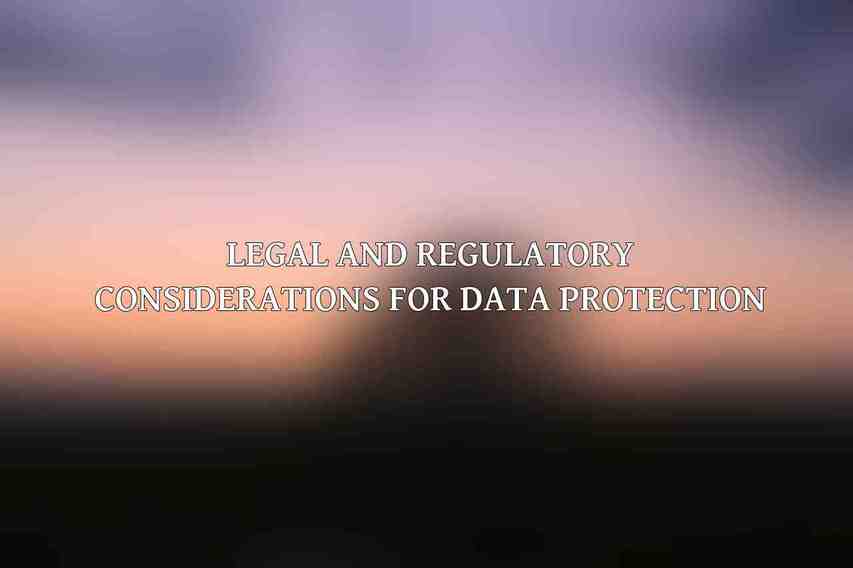Today, data protection has become a critical aspect of business operations. The increasing number of data breaches, stringent regulations, and the growing emphasis on privacy have made it imperative for businesses to prioritize robust data protection measures. Developing and implementing effective data protection policies is not only essential for regulatory compliance but also for maintaining customer trust and safeguarding brand reputation.
The Imperative of Robust Data Protection
The data privacy world is constantly evolving, with a rise in cyber threats and regulatory frameworks. Data breaches can have severe consequences, including financial losses, legal liabilities, and reputational damage. In a world where data is increasingly valuable, organizations must take proactive measures to secure sensitive information and mitigate risks.
Effective data protection goes beyond mere compliance; it is an investment in the long-term sustainability and credibility of a business. By prioritizing data security, organizations can build trust with customers, enhance brand reputation, and differentiate themselves in a competitive market.
Crafting Data Protection Policies: A Step-by-Step Guide
When crafting data protection policies, following a structured approach is crucial to ensure comprehensive coverage and alignment with business objectives. Here is a step-by-step guide to help organizations establish robust data protection frameworks:
Laying the Foundation: Defining Scope and Purpose
Begin by clearly defining the scope and purpose of your data protection policies. Identify the key objectives, target audience, and overarching goals of the policies to ensure alignment with business strategies.
Identifying and Classifying Data: Types of Data, Data Sensitivity Levels
Classify data based on its sensitivity and criticality to the organization. Differentiate between personal data, sensitive information, and confidential records to apply appropriate security measures accordingly.
Establishing Data Security Controls: Physical, Technical, and Administrative Measures
Implement a combination of physical, technical, and administrative controls to safeguard data throughout its lifecycle. This may include encryption, access controls, surveillance systems, and security protocols.
Implementing Data Access Management: Role-Based Access, Least Privilege Principle
Adopt a role-based access control mechanism to limit data access to authorized personnel only. Follow the principle of least privilege to restrict permissions based on job roles and responsibilities.
Data Privacy Principles and Ethics: Consent, Transparency, Data Subject Rights
Integrate data privacy principles such as consent, transparency, and respect for data subject rights into your policies. Uphold ethical standards in data handling and processing to foster trust with stakeholders.
Best Practices for Effective Data Protection Policies
To enhance the effectiveness of data protection policies, consider the following best practices:
Tailor Policies to Business Needs: Industry-Specific Considerations, Compliance Requirements
Customize your data protection policies to align with industry-specific regulations and compliance standards. Address unique risks and challenges within your sector to ensure comprehensive protection.
Regularly Review and Update: Keeping Pace with Evolving Technologies and Regulations
Stay current with emerging technologies and regulatory changes to adapt your policies accordingly. Conduct regular reviews and updates to address new threats and incorporate best practices.
Employee Training and Awareness: Empowering Staff to Protect Data
Invest in comprehensive training programs to educate employees on data protection policies and protocols. Foster a culture of security awareness to empower staff in safeguarding sensitive information.
Incident Response Planning: Procedures for Data Breaches or Security Incidents
Develop a robust incident response plan to effectively manage data breaches or security incidents. Define roles, responsibilities, and escalation procedures to respond promptly to threats.
Key Components of Data Protection Policies
The key components of data protection policies include:
| Component | Description |
|---|---|
| Statement of Purpose and Scope | Clearly outline the objectives and boundaries of the policies |
| Data Classification and Handling Procedures | Categorize data based on sensitivity and define handling protocols |
| Physical, Technical, and Administrative Security Measures | Implement comprehensive controls to secure data assets |
| Data Access Controls and Authorization Process | Define access rights and approval mechanisms |
| Employee Responsibilities and Training Requirements | Outline roles and training expectations for staff |
| Data Breach Reporting and Incident Response | Establish procedures for reporting breaches and responding effectively |
Legal and Regulatory Considerations for Data Protection

Navigating the complex world of data protection laws and regulations requires a comprehensive understanding of key frameworks and compliance requirements. Consider the following aspects:
Understanding Data Protection Laws: GDPR, CCPA, PCI DSS, and HIPAA
Familiarize yourself with prominent data protection laws such as the General Data Protection Regulation (GDPR), California Consumer Privacy Act (CCPA), Payment Card Industry Data Security Standard (PCI DSS), and Health Insurance Portability and Accountability Act (HIPAA).
Compliance with Data Protection Frameworks: ISO 27001, NIST Cybersecurity Framework
Align your data protection policies with internationally recognized frameworks such as ISO 27001 and the NIST Cybersecurity Framework. Adhering to these standards can help enhance security posture and demonstrate compliance.
Data Subject Rights and International Regulations: Right to Access, Right to Erasure, Transborder Data Flow
Respect data subject rights by enabling individuals to access, correct, or delete their personal information as mandated by regulations. Address transborder data flows carefully to ensure lawful and secure data transfer across borders.
Implementing Data Protection Policies
Effective implementation of data protection policies involves a coordinated effort encompassing communication, technology deployment, and ongoing monitoring. Consider the following strategies:
Communication and Training: Educating Employees about Policies and Responsibilities
Conduct regular training sessions and awareness campaigns to educate employees about data protection policies, procedures, and their roles in safeguarding information assets.
Data Security Tools and Technologies: Implementing Firewalls, Intrusion Detection Systems, Encryption
Deploy robust security tools and technologies to enhance data protection capabilities. Consider using firewalls, intrusion detection systems, encryption, and other safeguards to fortify your defenses.
Policy Enforcement and Monitoring: Regular Audits, Compliance Assessments, Data Loss Prevention
Establish mechanisms for policy enforcement through regular audits, compliance assessments, and data loss prevention measures. Monitor security incidents and investigate anomalies to maintain a secure environment.
Data Protection Governance and Compliance

To ensure sustainable data protection practices, organizations should focus on governance, compliance, and oversight mechanisms. Consider the following measures:
Establishing a Data Protection Committee: Leadership and Accountability
Form a dedicated data protection committee comprising key stakeholders to oversee policy implementation, monitor compliance, and address emerging threats proactively.
Continuous Monitoring and Auditing: Ensuring Compliance and Effectiveness
Conduct regular monitoring and auditing activities to evaluate the effectiveness of data protection policies. Identify gaps, assess risks, and implement remedial actions to enhance compliance.
Third-Party Vendor Management: Ensuring Data Privacy and Security in Outsourcing Relationships
Enforce stringent vendor management practices to safeguard data privacy and security in third-party relationships. Implement robust contractual agreements and due diligence processes to mitigate risks effectively.
crafting effective data protection policies is a strategic imperative for businesses operating in a data-driven environment. By following a structured approach, embracing best practices, and staying abreast of legal requirements, organizations can establish a strong foundation for protecting sensitive information and fostering trust with stakeholders. Emphasizing governance, compliance, and continuous improvement will enable businesses to navigate the complexities of data protection successfully in the ever-evolving digital world.
Frequently Asked Questions
What is the importance of data protection policies for a business?
Data protection policies are essential for businesses to safeguard sensitive information, maintain customer trust, and comply with data privacy regulations.
How should businesses determine what data to protect?
Businesses should conduct a data inventory to identify and classify all types of data they collect, store, and process. This will help determine which data requires protection.
What should be included in a data protection policy?
A data protection policy should outline the types of data collected, how it is stored and secured, who has access to the data, how data breaches are handled, and the procedures for data retention and disposal.
How can businesses ensure employees comply with data protection policies?
Businesses should provide regular training on data protection policies, clearly communicate expectations, conduct audits to monitor compliance, and implement consequences for policy violations.
How often should data protection policies be reviewed and updated?
Data protection policies should be reviewed and updated on a regular basis, at least annually, to reflect changes in technology, regulations, and business practices.

